Troy-Bilt Big Red Garden Tiller Owner's Manual
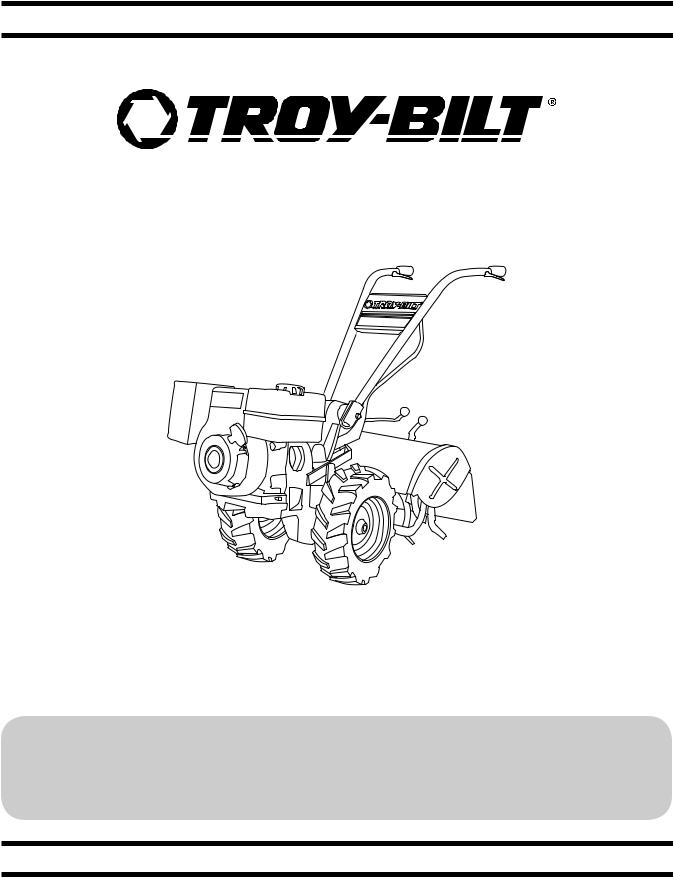
Safe Operation Practices • Set-Up • Operation • Maintenance • Service • Troubleshooting • Warranty
Operator’s Manual
Rear-Tine Tiller — Horse/Big Red
 WARNING
WARNING
READ AND FOLLOW ALL SAFETY RULES AND INSTRUCTIONS IN THIS MANUAL
BEFORE ATTEMPTING TO OPERATE THIS MACHINE.
FAILURE TO COMPLY WITH THESE INSTRUCTIONS MAY RESULT IN PERSONAL INJURY.
TROY-BILT LLC, P.O. BOX 361131 CLEVELAND, OHIO 44136-0019
Printed In USA |
Form No. 769-08675 |
|
(November 16, 2012) |
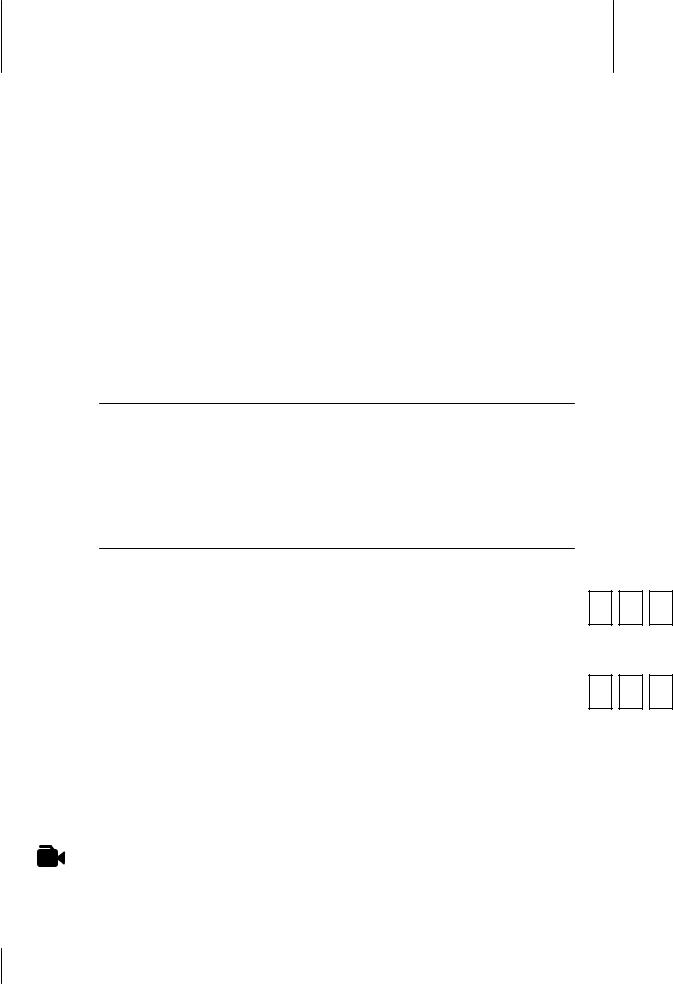
To The Owner
Thank You
Thank you for purchasing a Troy-Bilt Garden Tiller. It was carefully engineered to provide excellent performance when properly operated and maintained.
Please read this entire manual prior to operating the equipment. It instructs you how to safely and easily set up, operate and maintain your machine. Please be sure that you, and any other persons who will operate the machine, carefully follow the recommended safety practices at all times. Failure to do so could result in personal injury or property damage.
All information in this manual is relative to the most recent product information available at the time of printing. Review this manual frequently to familiarize yourself with the machine, its features and operation. Please be aware that this Operator’s
Manual may cover a range of product specifications for various models. Characteristics and features discussed and/or illustrated in this manual may not be applicable to all models. We reserve the right to change product specifications, designs and equipment without notice and without incurring obligation.
1
If applicable, the power testing information used to establish the power rating of the engine equipped on this machine can be found at www.opei.org or the engine manufacturer’s web site.
If you have any problems or questions concerning the machine, phone a authorized Troy-Bilt service dealer or contact us directly.
Troy-Bilt’s Customer Support telephone numbers, website address and mailing address can be found on this page. We want to ensure your complete satisfaction at all times.
Throughout this manual, all references to right and left side of the machine are observed from the operating position
The engine manufacturer is responsible for all engine-related issues with regards to performance, power-rating, specifications, warranty and service. Please refer to the engine manufacturer’s Owner’s/Operator’s Manual, packed separately with your machine, for more information.
Table of Contents
Safe Operation Practices......................................... |
3 |
Service..................................................................... |
38 |
Assembly & Set-Up................................................... |
7 |
Troubleshooting...................................................... |
41 |
Controls & Features................................................ |
13 |
Replacement Parts................................................. |
42 |
Operation................................................................ |
14 |
Warranty................................................... |
Back Cover |
Maintenance & Adjustments................................ |
26 |
|
|
Record Product Information |
Model Number |
|
|
|
|
|
|
|
|
|||||||||
Before setting up and operating your new equipment, please |
|
|
|
|
|
|
|
|
|
|
|
|
|
|
|
|
|
|
|
|
|
|
|
|
|
|
|
|
|
|
|
|
|
|
|
||
locate the model plate on the equipment and record the |
|
|
|
|
|
|
|
|
|
|
|
|
|
|
|
|
|
|
information in the provided area to the right. You can locate the |
|
|
|
|
|
|
|
|
|
|
|
|
|
|
|
|
|
|
|
|
|
|
|
|
|
|
|
|
|
|
|
|
|
|
|
||
model plate by standing at the operator’s position and looking |
Serial Number |
|
|
|
|
|
|
|
|
|||||||||
down at the rear of the deck. This information will be necessary, |
|
|
|
|
|
|
|
|
||||||||||
should you seek technical support via our web site, Customer |
|
|
|
|
|
|
|
|
|
|
|
|
|
|
|
|
|
|
|
|
|
|
|
|
|
|
|
|
|
|
|
|
|
|
|
||
Support Department, or with a local authorized service dealer. |
|
|
|
|
|
|
|
|
|
|
|
|
|
|
|
|
|
|
|
|
|
|
|
|
|
|
|
|
|
|
|
|
|
|
|
||
|
|
|
|
|
|
|
|
|
|
|
|
|
|
|
|
|
|
|
|
|
|
|
|
|
|
|
|
|
|
|
|
|
|
|
|
|
|
Customer Support
Please do NOT return the machine to the retailer or dealer without first contacting the Customer Support Department.
If you have difficulty assembling this product or have any questions regarding the controls, operation, or maintenance of this machine, you can seek help from the experts. Choose from the options below:
◊Visit us on the web at www.troybilt.com
See How-to Maintenance and Parts Installation Videos at www.troybilt.com/tutorials
◊Call a Customer Support Representative at (800) 828-5500 or (330) 558-7220
◊Write to Troy-Bilt LLC • P.O. Box 361131 • Cleveland, OH • 44136-0019
2
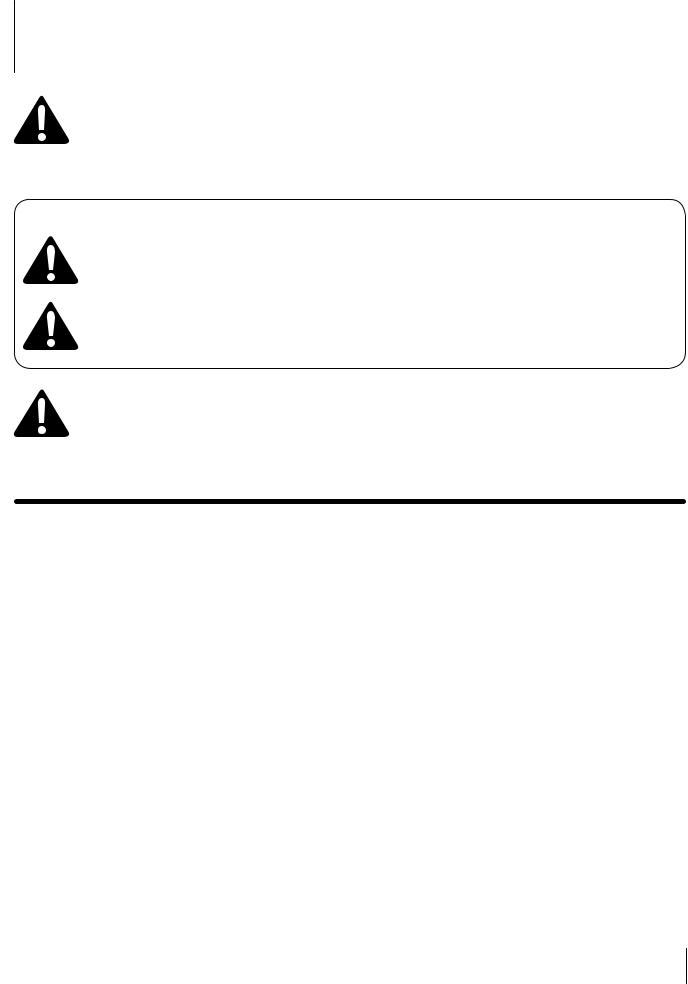
Important Safe Operation Practices |
2 |
|
|
|
|
WARNING! This symbol points out important safety instructions which, if not followed, could endanger the personal safety and/or property of yourself and others. Read and follow all instructions in this manual before attempting to operate this machine. Failure to comply with these instructions may result in personal injury.
When you see this symbol. HEED ITS WARNING!
CALIFORNIA PROPOSITION 65
WARNING! Engine Exhaust, some of its constituents, and certain vehicle components contain or emit chemicals known to State of California to cause cancer and birth defects or other reproductive harm.
WARNING! Battery posts, terminals, and related accessories contain lead and lead compounds, chemicals known to the State of California to cause cancer and reproductive harm. Wash hands after handling
DANGER! This machine was built to be operated according to the safe operation practices in this manual. As with any type of power equipment, carelessness or error on the part of the operator can result in serious injury. This machine is capable of amputating fingers, hands, toes and feet. Failure to observe the following safety instructions could result in serious injury or death.
Training
1.Read, understand, and follow all instructions on the machine and in the manual(s) before attempting to assemble and operate. Keep this manual in a safe place for future and regular reference and for ordering replacement parts.
2.Be familiar with all controls and their proper operation. Know how to stop the machine and disengage them quickly.
3.Never allow children under 14 years of age to operate this machine. Children 14 and over should read and understand the instructions and safe operation practices in this manual and on the machine and be trained and supervised by an adult.
4.Never allow adults to operate this machine without proper instruction.
5.Keep the area of operation clear of all persons, particularly small children and pets. Stop machine if anyone enters the area.
Preparation
1.Thoroughly inspect the area where the equipment is to be used. Remove all stones, sticks, wire, and other foreign objects which could be tripped over and cause personal injury.
2.Wear sturdy, rough-soled work shoes and close fitting slacks and shirt. Loose fitting clothes or jewelry can be caught in moving parts. Never operate this machine in bare feet or sandals.
3.Disengage clutch levers and shift (if provided) into neutral (“N”) before starting the engine.
4.Never leave this machine unattended with the engine running.
5.Never attempt to make any adjustments while engine is running, except where specifically recommended in the operator’s manual.
Safe Handling of Gasoline:
To avoid personal injury or property damage use extreme care in handling gasoline. Gasoline is extremely flammable and the vapors are explosive. Serious personal injury can occur when gasoline is spilled on yourself or your clothes which can ignite. Wash your skin and change clothes immediately.
a.Use only an approved gasoline container.
b.Never fill containers inside a vehicle or on a truck or trailer bed with a plastic liner. Always place containers on the ground away from your vehicle before filling.
3
c.When practical, remove gas-powered equipment from the truck or trailer and refuel it on the ground. If this is not possible, then refuel such equipment on a trailer with a portable container, rather than from a gasoline dispenser nozzle.
d.Keep the nozzle in contact with the rim of the fuel tank or container opening at all times until fueling is complete. Do not use a nozzle lock-open device.
e.Extinguish all cigarettes, cigars, pipes and other sources of ignition.
f.Never fuel machine indoors.
g.Never remove gas cap or add fuel while the engine is hot or running. Allow engine to cool at least two minutes before refueling.
h.Never over fill fuel tank. Fill tank to no more than ½ inch below bottom of filler neck to allow space for fuel expansion.
i.Replace gasoline cap and tighten securely.
j.If gasoline is spilled, wipe it off the engine and equipment. Move unit to another area. Wait 5 minutes before starting the engine.
k.To reduce fire hazards, keep machine free of grass, leaves, or other debris build-up. Clean up oil or fuel spillage and remove any fuel soaked debris.
l.Never store the machine or fuel container inside where there is an open flame, spark or pilot light as on a water heater, space heater, furnace, clothes dryer or other gas appliances.
Operation
1.Do not put hands or feet near rotating parts. Contact with the rotating parts can amputate hands and feet.
2.Do not operate machine while under the influence of alcohol or drugs.
3.Never operate this machine without good visibility or light. Always be sure of your footing and keep a firm hold on the handles.
4.Keep bystanders away from the machine while it is in operation. Stop the machine if anyone enters the area.
5.Be careful when tilling in hard ground. The tines may catch in the ground and propel the tiller forward. If this occurs, let go of the handle bars and do not restrain the machine.
6.Exercise extreme caution when operating on or crossing gravel surfaces. Stay alert for hidden hazards or traffic. Do not carry passengers.
7.Never operate the machine at high transport speeds on hard or slippery surfaces.
8.Exercise caution to avoid slipping or falling.
9.Look down and behind and use care when in reverse or pulling machine towards you.
10.Start the engine according to the instructions found in this manual and keep feet well away from the tines at all times.
11.After striking a foreign object, stop the engine, disconnect the spark plug wire and ground against the engine. Thoroughly inspect the machine for any damage. Repair the damage before starting and operating.
12.Disengage all clutch levers (if fitted) and stop engine before you leave the operating position (behind the handles). Wait until the tines come to a complete stop before unclogging the tines, making any adjustments, or inspections.
13.Never run an engine indoors or in a poorly ventilated area. Engine exhaust contains carbon monoxide, an odorless and deadly gas.
14.Muffler and engine become hot and can cause a burn. Do not touch.
15.Use caution when tilling near fences, buildings and underground utilities. Rotating tines can cause property damage or personal injury.
16.Do not overload machine capacity by attempting to till soil too deep at too fast of a rate.
17.If the machine should start making an unusual noise or vibration, stop the engine, disconnect the spark plug wire and ground it against the engine. Inspect thoroughly for damage. Repair any damage before starting and operating.
18.Keep all shields, guards, and safety devices in place and operating properly.
19.Never pick up or carry machine while the engine is running.
20.Use only attachments and accessories approved by the manufacturer. Failure to do so can result in personal injury.
21.If situations occur which are not covered in this manual, use care and good judgement. Contact Customer Support for assistance and the name of you nearest servicing dealer..
Maintenance & Storage
1.Keep machine, attachments and accessories in safe working order.
2.Allow a machine to cool at least five minutes before storing. Never tamper with safety devices. Check their proper operation regularly.
3.Check bolts and screws for proper tightness at frequent intervals to keep the machine in safe working condition. Also, visually inspect machine for any damage.
4.Before cleaning, repairing, or inspecting, stop the engine and make certain the tines and all moving parts have stopped. Disconnect the spark plug wire and ground it against the engine to prevent unintended starting.
5.Do not change the engine governor settings or over-speed the engine. The governor controls the maximum safe operating speed of engine.
6.Maintain or replace safety and instruction labels, as necessary.
7.Follow this manual for safe loading, unloading, transporting, and storage of this machine.
8.Always refer to the operator’s manual for important details if the machine is to be stored for an extended period.
4 |
|
Section 2 — Important Safe Operation Practices |
|
||
|
|
|

9.If the fuel tank has to be drained, do this outdoors.
10.Observe proper disposal laws and regulations for gas, oil, etc. to protect the environment.
11.According to the Consumer Products Safety Commission (CPSC) and the U.S. Environmental Protection Agency (EPA), this product has an Average Useful Life of seven (7) years,
or 130 hours of operation. At the end of the Average Useful Life have the machine inspected annually by an authorized service dealer to ensure that all mechanical and safety systems are working properly and not worn excessively. Failure to do so can result in accidents, injuries or death.
Notice Regarding Emissions
Engines which are certified to comply with California and federal
EPA emission regulations for SORE (Small Off Road Equipment) are certified to operate on regular unleaded gasoline, and may include the following emission control systems: Engine
Modification (EM), Oxidizing Catalyst (OC), Secondary Air
Injection (SAI) and Three Way Catalyst (TWC) if so equipped.
Spark Arrestor
WARNING! This machine is equipped with an internal combustion engine and should not be used on or near any unimproved forest-covered, brushcovered or grass-covered land unless the engine’s exhaust system is equipped with a spark arrestor meeting applicable local or state laws (if any).
If a spark arrestor is used, it should be maintained in effective working order by the operator. In the State of California the above is required by law (Section 4442 of the California Public Resources Code). Other states may have similar laws. Federal laws apply on federal lands.
A spark arrestor for the muffler is available through your nearest engine authorized service dealer or contact the service department, P.O. Box 361131 Cleveland, Ohio 44136-0019.
Section 2 — Important Safe Operation Practices |
|
5 |
|
||
|
|
|
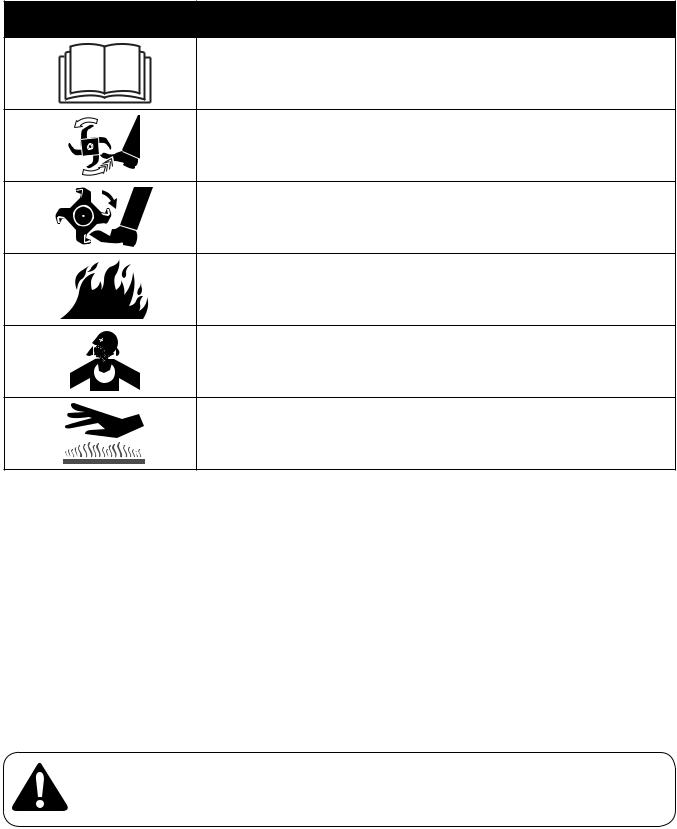
Safety Symbols
This page depicts and describes safety symbols that may appear on this product. Read, understand, and follow all instructions on the machine before attempting to assemble and operate.
Symbol |
Description |
READ THE OPERATOR’S MANUAL(S)
Read, understand, and follow all instructions in the manual(s) before attempting to assemble and operate
WARNING— ROTATING TINES
Do not put hands or feet near rotating parts. Contact with the rotating parts can amputate hands and feet.
WARNING— ROTATING TINES
Do not put hands or feet near rotating parts. Contact with the rotating parts can amputate hands and feet.
WARNING—GASOLINE IS FLAMMABLE
Allow the engine to cool at least two minutes before refueling.
WARNING— CARBON MONOXIDE
Never run an engine indoors or in a poorly ventilated area. Engine exhaust contains carbon monoxide, an odorless and deadly gas.
WARNING— HOT SURFACE
Engine parts, especially the muffler, become extremely hot during operation. Allow engine and muffler to cool before touching.
WARNING! Your Responsibility—Restrict the use of this power machine to persons who read, understand and follow the warnings and instructions in this manual and on the machine.
SAVE THESE INSTRUCTIONS!
6 |
|
Section 2 — Important Safe Operation Practices |
|
||
|
|
|
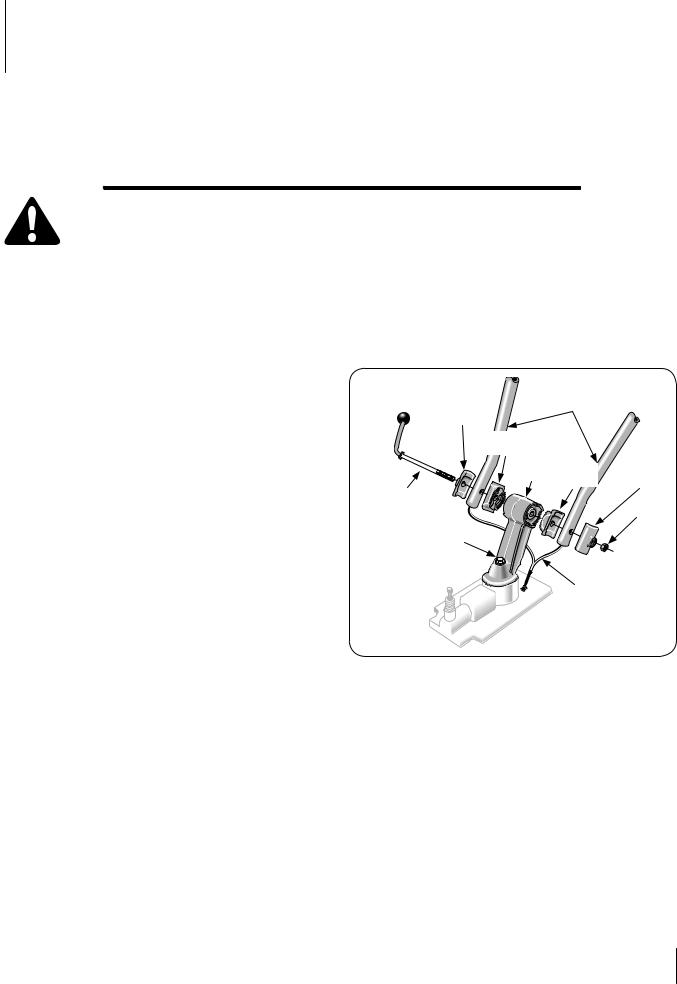
Assembly & Set-Up |
3 |
|
|
Contents of Carton |
|
|
• |
One Tiller |
• |
One Handlebar Support |
• |
One Handlebar Assembly |
• |
One Hardware Pack |
• |
One Wheels/Tines PTO Lever |
• |
One Operator’s Manual |
•One Engine Operator’s Manual
|
WARNING! To prevent personal injury or property |
3. |
Check that you have the items listed above (contact your |
|
|
damage, do not start the engine until all assembly |
|
local dealer or the Troy-Bilt Technical Service Department if |
|
|
steps are complete and you have read and |
|
any items are missing or damaged). |
|
|
understand the safety and operating instructions in |
Handle |
||
|
this manual. |
|||
|
NOTE: When disassembling the handlebar assembly, keep the |
|||
Recommended Tools for Assembly |
||||
left-side clamp and ratchet separated from the right-side clamp |
||||
• |
3⁄8” open-end wrench (1) |
and ratchet. |
||
1. |
Disassemble the handlebar assembly. To do this, remove |
|||
• |
7⁄16” open-end wrench (2) |
|||
|
the height adjustment lever by turning the lever in a |
|||
• |
1⁄2” open-end wrench (2) |
|
||
|
counterclockwise direction. See Figure 3-1. |
|||
•9⁄16” open-end wrench (1)
• 3⁄4” open-end wrench (1)
• |
Flat blade screwdriver (1) |
|
Right |
Handlebars |
|
|
• |
Scissors (to trim plastic ties) |
|
Clamp |
|
|
|
|
|
Right |
|
|
||
• |
Tire pressure gauge (1) |
|
|
|
|
|
|
|
Ratchet |
|
|
||
• |
4-1⁄2” high wood block to prop machine |
|
|
Base |
Left |
Left |
|
|
Height |
|
Ratchet |
||
Contents of Hardware Pack |
|
Clamp |
||||
|
|
|
||||
Adjustment |
|
|
|
|
||
|
|
|
|
|
|
|
• |
26 oz. Bottle SAE 30W Oil (1) |
Lever |
Base |
|
|
Nut |
• |
Clutch Pawl Spring (1) |
|
|
|
|
|
|
Bolt |
|
|
|
||
• |
Belt Adjusting Tool (1) |
|
|
|
|
|
• |
Plastic Cable Ties (2) |
|
|
|
Wire Harness |
|
• |
Curved Head Screw, 1⁄4-20 x 2 (1) |
|
|
|
||
|
|
|
|
|
||
• Flanged Lock Nut, 1⁄4-20 (1)
• Pan Head Screw, #10-32 x 1⁄2 (1)
•The following parts (electric start models only), packaged
|
separately. |
|
Figure 3-1 |
• |
Nuts, 1⁄4-20 for battery terminals (2) |
2. |
Place the handlebar ends on either side of the base, with |
• |
Screws, 1⁄4-20 x 5⁄8 for battery terminals (2) |
|
the wire harness toward the rear of the base See Figure 3-1. |
• |
Keys in ignition switch (2) |
3. |
Install the height adjustment lever through the right-side |
Assembly |
|
clamp, handlebar end, ratchet, and base; then out through |
|
|
the left-side ratchet, handlebar end, and clamp. See Figure |
||
Unpacking Instructions |
|
3-1. Secure with the nut, but do not fully tighten. |
|
|
NOTE: Do not force the height adjustment lever through |
||
NOTE: Do not severely bend any of the control cables on the |
|
||
|
the handlebars. The interlock wires may be blocking the |
||
tiller. |
|
|
lever and could be damaged. You may gently move the |
1. |
The tiller is heavy. Do not attempt to remove it from |
|
wires aside if this condition occurs. |
|
|
||
|
the shipping platform until instructed to do so in these |
4. |
Raise the handlebars to one of two height settings and |
|
assembly steps. |
|
tighten the height adjustment lever. Also, make sure all |
2. |
Remove all loose parts from the carton. The hardware bag |
|
other mounting hardware is securely tightened. |
|
|
||
is included in your literature packaging.
7
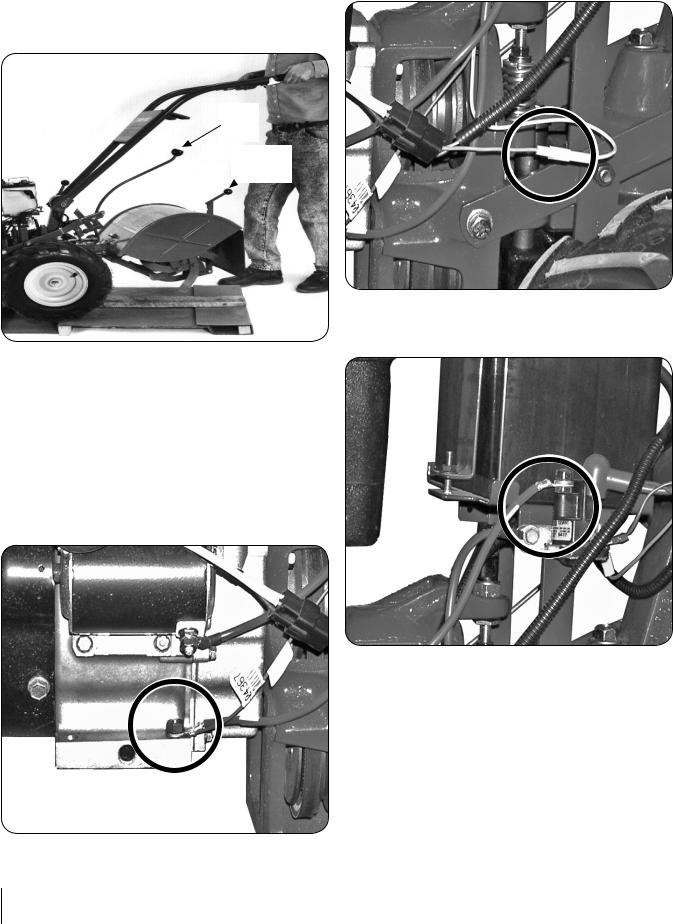
Moving the Tiller off the Shipping Platform
1.Set the Depth Regulator Lever to the “TRAVEL” position. Do this by lifting the tiller by the handlebars, then pulling straight back on the lever and sliding down to the highest notched setting. See Figure 3-2.
Wheel
Speed
Lever
Depth
Regulator
 Lever
Lever
Figure 3-2
2.Set the Wheel Speed Lever to the Freewheel position. To do this, move the lever approximately halfway between the Fast and Slow settings while you rock the tiller forward and backward until the wheels move freely. See Figure 3-2.
3.Lift the Handlebars high enough to clear the tiller tines and pull back firmly to dislodge the tiller from the platform wheel wells.
Wire Harness
1.Ground the green (and red for electric start tillers) wire(s) to the engine block. See Figure 3-3.
Figure 3-3
2.Connect the safety wire assembly (green and yellow wires).
See Figure 3-4.
Figure 3-4
3.Connect the tiller’s main harness connection to the neutral safety switch receptacle. See Figure 3-5.
Figure 3-5
8 Section 3— Assembly & Set-Up
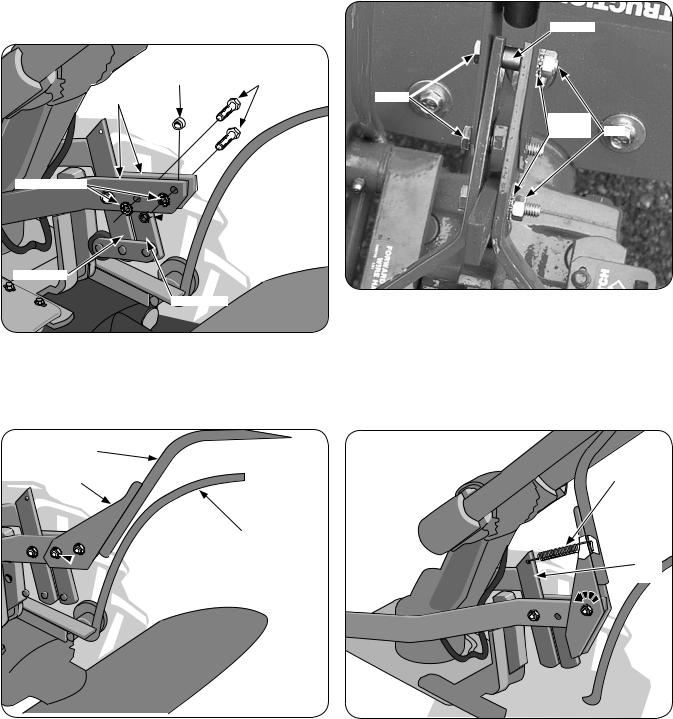
Wheels/Tines PTO Drive Lever
1.Loosen the bolt on the handlebar base and swing the handlebars out to the right side. See Figure 3-1.
2.Remove both sets of nuts, star washers, screws, and one bushing from the yoke plates. See Figure 3-6. There is a bushing inside the short link. Be careful not to lose it when removing screw.
Bushing Screw
Yoke Plates
Star Washers


 Nut
Nut
Long Link
Short Link
Figure 3-6
3.Slide the plates at the end of the Wheels/Tines/PTO Lever over the yoke plates. See Figure 3-7. To aid in the next step, insert a screw temporarily into the forward most holes of the yoke plates and the lever.
Wheels/Tines/PTO
Drive Lever
Plates
Wheel
Speed
Lever

 Forward Hole
Forward Hole
Figure 3-7
4.Align the rear most holes of the yoke plates and the
Wheels/Tines PTO Lever. Use long nose pliers to hold the bushing in place while inserting the screw through the lever and yoke plates. See Figure 3-8. Install the star washer and the nut then hand tighten.
Bushing
Screw 
Star
Washer Nut
Figure 3-8
5.Retrieve the clutch pawl spring from hardware bag. Remove the temporary screw from the forward holes inserted in Step 3 and move the Wheels/Tines/PTO Lever fully forward. Install the wider hook end of the clutch pawl spring down into the small hole at the end of the handle. Use pliers to insert the other end into the hole in the long link bar. See Figure 3-9.
Clutch
Pawl
Spring
Long
Link
Bar
Figure 3-9
NOTE: Do not bend or over stretch the spring while installing.
Section 3 — Assembly & Set-Up |
|
9 |
|
||
|
|
|
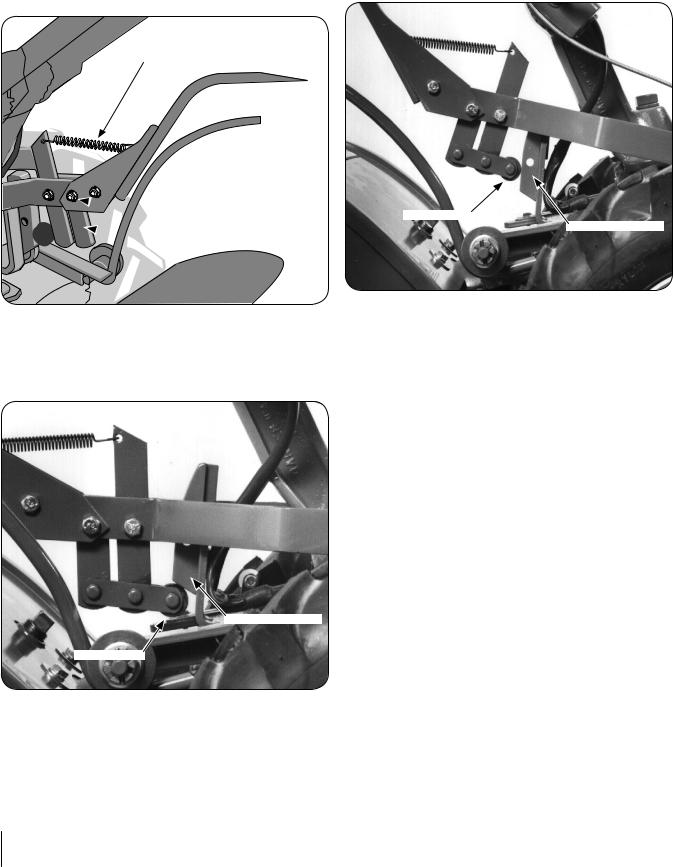
6.Pull the Wheels/Tines/PTO Lever back to align the forward most holes in the yoke plate with the holes in the lever plates. Also align the bushing that is inside the short link bar. Install the screw, star washer, and nut, then tighten securely. Securely tighten all other hardware. Also ensure that the spring is properly seated at both ends. Completed assembly should appear as illustrated in Figure 3-10.
Clutch Pawl Spring
8.To test Reverse, lift and hold the lever all the way up in the Reverse position, then let it go. The lever should automatically return to the Neutral position. See Figure
3-12. If not, do not use the tiller. See your local authorized dealer or call the TROYBILT Technical Service Department for instructions.
 Forward Hole
Forward Hole


 Short Link Bar
Short Link Bar
Figure 3-10
7.Test the operation of the Wheels/Tines/PTO Lever. Push the lever down until it engages in the Forward position. The clutch roller must rest beneath the adjustment block. Next, move the lever up to the Neutral position. See Figure 3-11.
Adjustment Block
Clutch Roller
Figure 3-11
Clutch Roller
Adjustment Block
Figure 3-12
10 Section 3— Assembly & Set-Up
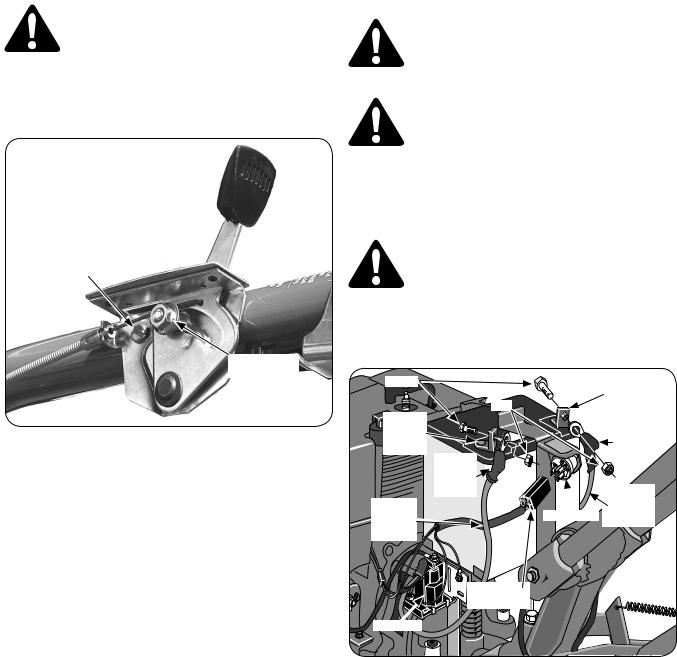
Engine Throttle Lever and Cable
For shipping purposes, the throttle cable, together with the throttle lever, is wound around the engine. Carefully unwind the cable. If the throttle control label is covered with a clear protective coating, peel it off.
WARNING! To avoid electric shock from a short circuit (electric start tillers only), never allow the throttle cable to touch the battery. Route the cable below the battery, on the outside of the battery holder.
To attach the throttle lever and cable:
1.Run the throttle cable up the inside edge of the right handlebar and position the lever as shown in Figure 3-13.
Pan Head
Screw
Curved Head
Screw
Figure 3-13
2.From the outside of the handlebar, insert the curved head screw, through the handlebar and the center hole in the throttle lever mounting bracket. See Figure 3-13.
3.Loosely install the flanged lock nut and move the throttle lever back to the STOP position.
4.From the lever side of the bracket, thread a pan head screw through the small hole in the throttle lever bracket and into the handlebar. Tighten the screw securely.
5.Securely tighten both the flanged lock nut and the curved head screw.
6.Use two plastic ties to secure the throttle cable to the right handlebar in two places. Loop each tie around the handlebar and cable (serrated side faces in) and pull the ties tight. Trim the ends.
Electric Start System (If Equipped)
The following steps explain how to install and charge the battery on electric start tillers. For your safety, follow all steps and observe all accompanying safety messages. The Maintenance & Adjustments section contains other general battery maintenance and recharging instructions.
WARNING! Battery produces explosive gases. Keep away sparks, flames, and cigarettes. Ventilate area when charging or using battery in an enclosed space. Make sure battery vent tube is always open after battery is filled with acid.
WARNING! Remove metal jewelry before working near the battery or near the electrical system. Failure to comply may cause a short circuit, resulting in electrical burns, a shock, or battery gas explosion.
NOTE: If the battery is put into service after the date shown on the top of the battery, charge for a minimum of one hour at 6-10 amps. Refer to the Maintenance & Adjustments section of this manual for more detailed instructions regarding proper battery charging procedure.
WARNING! Never jump start the battery with a vehicle battery or charging system. This may produce a battery explosion, causing acid or electrical burns.
1.Before installing the battery and its hold-down clamp, insert the plastic wire harness receptacle into the prongs of the keyswitch located on the hold-down clamp. See Figure
3-14.
Screw |
|
Negative |
|
Battery |
|
Nut |
|
|
|
Post |
|
Positive |
|
|
IL |
|
|
O |
|
|
Battery |
|
Black |
|
Rubber |
|
Post |
|
|
|
Boot |
|
Black |
|
|
|
|
|
Rubber |
|
|
Boot |
|
Negative |
Positive |
Keyswitch |
Battery |
Battery |
Cable |
|
Cable |
|
|
 Harness
Harness 
Receptacle
Selenoid
Figure 3-14
2.Remove the ignition keys from the keyswitch and store them safely away. Do not insert the key into the keyswitch until you complete this section and read the Operation section. See Figure 3-14.
Section 3 — Assembly & Set-Up |
|
11 |
|
||
|
|
|

3.Use a 5⁄8” long screw and 1⁄4-20 hex nut to connect the positive (+) battery cable to the positive (+) battery post. Make sure that this is the cable on the left side, with one end attached to the solenoid. See Figure 3-14.
WARNING! To Avoid Personal Injury or Property Damage: Do not touch the positive battery terminal and any surrounding metal objects with tools, jewelry or other metal items. Failure to comply could cause a short circuit leading to electrical burns or an explosion of battery gases. Never bring a gas can near the positive (+) battery terminal. A short circuit could occur leading to an explosion of the gasoline or the battery gases. Always fill the engine fuel tank from the front or side of the engine.
4.Slide the black rubber boot completely over the battery post and cable connector. See Figure 3-14.
5.Use a 5⁄8” long screw and 1⁄4-20 hex nut to connect the negative (-) battery cable to the negative (-) battery post and secure with screw and nut. See Figure 3-14.
6.Slide the black rubber boot completely over the battery post and cable connector. See Figure 3-14.
Set-Up
Tires
For shipping purposes, the tires may be overinflated. Check the air pressure in each tire and adjust them to between 10 and 20 pounds per square inch. You must inflate each tire to equal air pressures to prevent the tiller from pulling to one side.
Gas & Oil Fill-Up
Service the engine with gasoline and oil as instructed in the
Engine Operator’s Manual packed separately with your tiller.
Read the instructions carefully.
WARNING! Use extreme care when handling gasoline. Gasoline is extremely flammable and the vapors are explosive. Never fuel the machine indoors or while the engine is hot or running. Extinguish cigarettes, cigars, pipes and any other sources of ignition.
Transmission Gear Oil
The transmission was filled with gear oil at the factory. However, be sure to check the oil level at this time to make certain it
is correct. See the Maintenance & Adjustments section for instructions on checking and adding transmission gear oil.
12 Section 3— Assembly & Set-Up

Controls & Features |
4 |
|
|
|
|
Handlebar Height
Adjustment Lever
Tines/PTO Clutch Lever

WARNING! Be familiar with all the controls and their proper operation. Know how to stop the machine and disengage it quickly.
NOTE: For detailed information on all engine controls refer to the separate Engine Operator’s Manual.
Wheels/Tines/PTO Drive Lever
Use the Wheels/Tines/PTO Drive Lever to engage and disengage power to the transmission.
Forward Interlock Levers
The Forward Interlock Levers are attached under the handlebar grip and will stop the engine if both levers are released.
Wheel Speed Lever
The Wheel Speed Lever controls the speed at which the wheels spin.
Wheels/Tines/PTO
Drive Lever
Forward
Interlock
Levers
Depth Regulator
Lever
Wheel Speed Lever
Tines/PTO Clutch Lever
The Tines/PTO Clutch Lever is used to engage or disengage power to the transmission.
Depth Regulator Lever
The Depth Regulator Lever is used to regulate the tilling depth of the tines.
Handlebar Height Adjustment Lever
The Handlebar Height Adjustment Lever is used to adjust the handlebars to one of two heights.
Engine Throttle Lever
Use the throttle lever to adjust engine speed as well as to start and stop the engine.
Keyswitch Starter (If So Equipped)
The keyswitch starter on electric start models is used to start, run and stop the tiller.
13
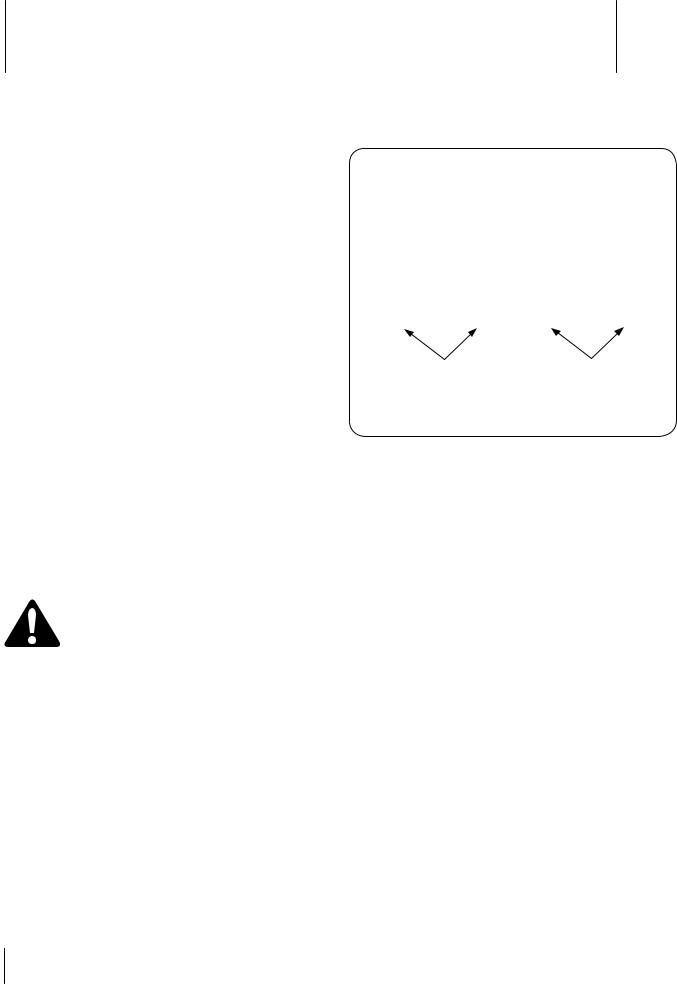
Operation
Starting the Engine
The following steps describe how to start and stop the engine.
NOTE: Do not attempt to engage the tines, wheels, or any PTO attachment until you have read all of the operating instructions in this section.
Pre-Start Checklist
Make the following checks and perform the following services before starting the engine.
1.Read the Safe Operation Practices and Features & Controls sections in this Manual. Read the separate Engine
Operator’s Manual.
2.Check the tiller for loose or missing hardware. Service as required.
3.Check the engine oil level. See Engine Operator’s Manual.
4.Shift the Wheels/Tines/PTO Drive lever into NEUTRAL position. See the Controls and Features section for more information on this lever.
5.Check the safety guards. All guards and covers must be securely in place.
6.Check the air cleaner. See the Engine Operator’s Manual.
7.Attach the spark plug wire to the spark plug.
8.Check Engine Cooling System. Clear cooling fins and air intake screen of debris. See the Engine Operator’s Manual.
9.Select High/Low Belt Speed range.
10.Adjust the Handlebar Height.
11.Fill the fuel tank with gasoline in accordance with the directions in the separate Engine Operator’s Manual.
Follow all instructions and safety rules carefully.
WARNING! Never run the engine indoors or in an enclosed, poorly ventilated area. Engine exhaust contains carbon monoxide, an odorless and deadly gas. Avoid engine muffler and nearby areas.
Temperatures in these areas may exceed 150° F.
NOTE: After the first two hours of operation, perform the maintenance procedures shown in the Maintenance Schedule in the Maintenance & Adjustments Section of this manual.
Starting the Engine
1.With the engine off, place the Wheels/Tines/PTO Drive Lever in the NEUTRAL position. If in the FORWARD position, tap the lever sharply upward, it should automatically move into NEUTRAL position.
2.Put the Depth Regulator Lever in the Travel position (lever all the way down) so that the tines are off the ground. To do this, lift up on the handlebars, pull the lever back, and push it down all the way to the top detent (notched) position.
3.Move the Wheel Speed Lever to either the SLOW or FAST position. Be sure to roll the wheels while shifting the lever until the wheels engage.
5
NOTE: If using a PTO stationary attachment, move the
Wheel Speed Lever into FREEWHEEL and block the wheels to prevent the equipment from moving. See Figure 5-1.
Blocks |
Blocks |
Figure 5-1
4.Move the Tines/PTO Clutch Lever into DISENGAGE position.
NOTE: Use the ENGAGE position if you want the tines to revolve or to apply power to a PTO-driven stationary attachment.
5.If the engine is equipped with a fuel valve, turn the valve to the OPEN position as instructed in the separate Engine Operator’s Manual.
6.If the engine is equipped with an ON/OFF switch, move the switch to ON. Move engine throttle lever away from STOP.
Choke or prime the engine as instructed in the separate
Engine Operator’s Manual.
7.If not equipped with an electric start system, place one hand on the fuel tank to stabilize the tiller when you pull the recoil starter rope.
8.If equipped with an electric start system, turn the key to START position to crank the engine then release when the engine starts. If the engine does not start right away, do not hold the key at START for more than a few seconds. Release then try again after a short pause. Damage to the starter motor can occur if it is cranked more than 15 seconds per minute.
9.If the engine does not start after a number of tries, refer to the Engine Operator’s Manual for specific instructions.
10.When the engine starts, move the Throttle Lever to the
SLOW position and then gradually move the choke lever (on engines so equipped) to OFF or RUN position.
11.Move the throttle speed control to FAST setting when tilling.
14
